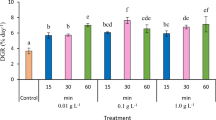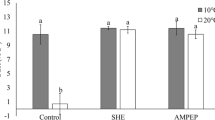Abstract
Ascophyllum nodosum is a brown seaweed that grows abundantly in the US Northeast coastal region. This study examined the seasonal variation of A. nodosum in phenolic contents and subsequent antioxidant, α-glucosidase and α-amylase inhibitory activities. A. nodosum was harvested monthly and extracted in hot water and the resulting extracts were spray-dried. The results indicate a clear seasonal variation in terms of phenolic content, with June and July being the highest (36.4 and 37 mg/g, respectively) and May the lowest (21.8 mg/g). The antioxidant activities, in terms of 1,1-diphenyl-2-picrylhydrazyl (DPPH) free radical scavenging activity, correlated with the phenolic contents observed (r = 0.81), with the month of July being the highest (58%) and April the lowest (26%). Similarly in terms of Trolox equivalent, July had the highest activity (15.53 μM) and April and May the lowest (8.40 and 8.27 μM, respectively). α-glucosidase inhibitory activity exhibited a pattern similar to the phenolic contents observed with July having the highest inhibitory activity (IC70 2.23 μg) and April the lowest (IC70 26.13 μg), resulting in an inverse correlation between IC70 values and total phenolic content (r = −0.89). Such seasonal variation is believed to be caused by temperature-related stress considering that A. nodosum is a cold water species.



Similar content being viewed by others
References
Elsenhans B, Caspary WF (1987) Absorption of carbohydrates. In: Caspary WF (ed), Structure and Function of the small intestine. Excerptia Medica, Amsterdam, pp 139–159
Krentz AJ, Bailey CJ (2005) Oral antidiabetic agents: Current role in type 2 diabetes mellitus. Drugs 65:385–411
Andlauer W, Furst P (2003) Special characteristics of non-nutrient food constituents of plants-phytochemicals. Introductory lecture. Int J Vitam Nut Res 73:55–62
Apostolidis E, Kwon Y-I, Shetty K (2006) Potential of cranberry - Based herbal synergies for diabetes and hypertension management. Asia Pac J Clin Nutr 15:433–41
Kwon Y-I, Apostolidis E, Kim Y-C, Shetty K (2007) Health benefits of traditional corn, beans and pumpkin: In vitro studies for hyperglycemia and hypertension management. J Med Food 10:266–275
Kwon Y-I, Vattem DA, Shetty K (2006) Clonal herbs of Lamiaceae species against diabetes and hypertension. Asia Pac J Clin Nutr 15:107–118
Horii S, Fukasse K, Matrua T, Kameda K, Asano N, Masui Y (1987) Synthesis and α-D- glucosidase inhibitory activity of N-substituted valiolamine derivatives as potent oral antidiabetic agents. J Med Chem 29:1036–1048
Centers For Disease Control And Prevention, National Center for Health Statistics (2010) Division of Health Interview Statistics, data from the National Health Interview Survey. U.S. Bureau of the Census, census of the population and population estimates. Available from: www.cdc.gov/diabetes/statistics/. Accessed October, 2010
World Health Organization (2009) Diabetes, Fact sheet N°312. Available from: http://www.who.int/mediacentre/factsheets/fs312/en/index.html . Accessed December, 2010
Taylor WR (1962) Marine algae of the northeastern coast of North America. University of Michigan Press, Ann Arbor. ISBN 0-472-04904-6
Chan C-X, Ho C-L, Phang S-M (2006) Trends in seaweed research. Trends Plant Sci 11:165–166
Ragan MA, Glombitza KW (1986) Phlorotannins, brown algal polyphenols. In: Round FE, Chapman DJ (eds), Progress in Phycological research. Biopress Ltd., Bristol, pp 129–241
Zhang J, Tiller C, Shen J, Wang C, Girouard GS, Dennis D, Barrow CJ, Miao M, Ewart S (2007) Antidiabetic properties of polysaccharide and polyphenolic enriched fractions from the brown seaweed Ascophyllum nodosum. Can J Physiol Pharmacol 85:1116–1123
Iwai K (2008) Antidiabetic and antioxidant effects of polyphenols in brown alga Ecklonia stolonifera in genetically diabetic KK-Ay Mice. Plant Foods Hum Nutr 63:163–169
Apostolidis E, Lee CM (2010) In vitro potential of Ascophyllum nodosum phenolic antioxidant mediated α-glucosidase and α-amylase inhibition. J Food Sci 75:97–102
McIntyre KL, Harris CS, Saleem A, Beaulieu LP, Ta CA, Haddad PS, Arnason JT (2009) Seasonal phytochemical variation of anti-glycation principles in lowbush blueberry (Vaccinium angustifolium). Planta Med 75:286–292
Jalal MAF, Readand DJ, Haslam E (1982) Phenolic composition and its seasonal variation in Calluna vulgaris. Phytochem 21:1397–1401
Erturk Y, Ercisli S, Sengul M, Eser Z, Haznedar A, Turan M (2010) Seasonal variation of total phenolic, antioxidant activity and minerals in fresh tea shoots (Camellia sinensis var. sinensis). Pak J Pharm Sci 23:69–74
Salminen J-P, Roslin T, Karonen M, Sinkkonen J, Pihlaja K, Pulkkinen P (2004) Seasonal variation in the content of hydrolyzable tannins, flavonoid glycosides, and proanthocyanidins in oak leaves. J Chem Ecol 30:1693–1711
Mooney HA (1972) The carbon balance of plants. Annu Rev Ecol Systemat 33:15–346
Mattson WJ Jr (1980) Herbivory in relation to plant nitrogen content. Annu Rev Ecol Evol Systemat 11:119–161
Bryant JP, Chapin FS, Klein DR (1983) Carbon/nutrient balance of boreal plants in relation to vertebrate herbivory. Oikos 40:357–368
Ilvessalo H, Tuomi J (1989) Nutrient availability and accumulation of phenolic compounds in the brown alga Fucus vesiculosus. Mar Biol 101:115–119
Gershenzon J (1984) Changes in the levels of plant secondary metabolites under water and nutrient stress. In: Timmermann BN, Steelink C, Loewus FA (eds), Phytochemical Adaptations to Stress. Plenum, New York, pp 273–320
Fajer ED, Bowers MD, Bazzaz FA (1992) The effect of nutrients and enriched CO2 environments on production of carbon-based allelochemicals in Plantago: A test of the carbon/nutrient balance hypothesis. Am Nat 140:707–723
Bryant JP, Heitkonig I, Kuropat P, Owen-Smith N (1991) Effects of severe defoliation on the long-term resistance to insect attack and on leaf chemistry in six woody species of the southern African savanna. Am Nat 137:50–63
Yates JL, Peckol P (1993) Effects of nutrient availability and herbivory on polyphenolics in the seaweed Fucus versiculosus. Ecol 74:1757–1766
Steinberg PD (1989) Biogeographical variation in brown algal polyphenolics and other secondary metabolites: Comparison between temperate Australasia and North America. Oecologia 78:373–382
Parys S, Kehraus S, Pete R, Kupper F, Glombitza KW, Konig GM (2009) Seasonal variation of polyphenolics in Ascophyllum nodosum (Phaeophycae). Eur J Phycol 44:331–338
Maine Seaweed Council (2010) Rockweed Research Priority Symposium, March 2010
Shetty K, Curtis OF, Levin RE, Witkowsky R, Ang W (1995) Prevention of vitrification associated with in vitro shoot culture of oregano (Origanum vulgare) by Pseudomonas spp. J Plant Physiol 147:447–451
Kurihara H, Fukami H, Asami S, Totoda Y, Nakai M, Shibata H, Yao XS (2004) Effects of oolong tea on plasma antioxidative capacity in mice loaded with restraint stress assessed using the oxygen radical absorbance capacity (ORAC) assay. Biol Pharm Bull 27:1093–1098
Bischoff H, Puls W, Krause HP, Schutt H, Thomas G (1985) Pharmacological properties of the novel glucosidase inhibitors BAY m 1099 (miglitol) and BAY o 1248. Diabetes Res Clin Pract 1:53–62
Acknowledgement
We would like to thank Professor Charles Yarish (Department of Ecology and Evolutionary Biology, University of Connecticut) for his valuable advice on A. nodosum collection sites and harvesting technique.
Author information
Authors and Affiliations
Corresponding author
Rights and permissions
About this article
Cite this article
Apostolidis, E., Karayannakidis, P.D., Kwon, YI. et al. Seasonal Variation of Phenolic Antioxidant-mediated α-glucosidase Inhibition of Ascophyllum nodosum . Plant Foods Hum Nutr 66, 313–319 (2011). https://doi.org/10.1007/s11130-011-0250-4
Published:
Issue Date:
DOI: https://doi.org/10.1007/s11130-011-0250-4




